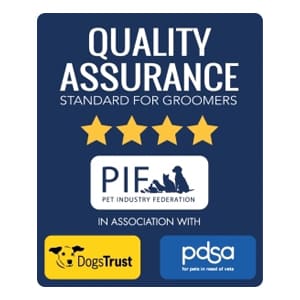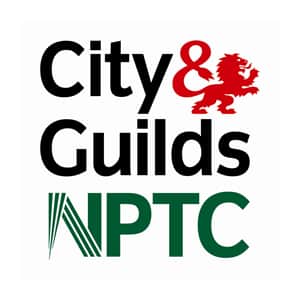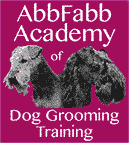City & Guilds Dog Grooming Level 3 - The 38-Day Diploma in Dog Grooming
City and Guilds 7863-03
The City & Guilds Level 3 Diploma in Dog Grooming (7863-03 ) is the industry-standard qualification for professional dog groomers. It has existed for many years and is considered to be the best qualification available for commercial dog groomers.
It is delivered over 38 on-site training days and you will need to hold the City and Guilds Level 2 Certificate For Dog Grooming Assistants before you can enrol on the Level 3 course.
The majority of our students take the Level 3 course as part of our 55 day course, which combines the City and Guilds Levels 2 and 3 qualifications.
The City and Guilds Level 3 Diploma in Dog Grooming builds on the skills learned at Level 2. At Level 3 you will learn how to apply different shapes and styles on a variety of different breeds and coat-types. It is essential that you maintain all the skills and knowledge that you gained at Level 2.
The minimum age for enrolling onto this course is 16 and there is no upper age limit. Our students have come from all different walks of life and all different parts of the U.K and the world. All students can expect to be treated fairly and equally at Abbfabb Academy.
You may see the City and Guilds Level 3 qualification offered over a shorter training period than ours. We believe that in order for a candidate to achieve the maximum learning from our courses, enough time is needed for you to actually learn the basic skills and underpinning knowledge required to achieve this qualification, as opposed to just having boxes ticked.
City and Guilds have very clear guidelines about the hours a candidate has to achieve in order to gain the Level 3 Diploma. You are required to complete a minimum of 300 guided learning hours which is spread over the practical and theory components. Most of our students complete around 450 hours.
There are two reasons that we don’t offer intensive courses. Firstly, dog grooming isn’t something that can be mastered in five minutes. It’s a skill that covers many aspects of animal care as well as the trimming and styling, and for you to be able to actually learn them you need time… time to absorb what you’ve learned, time to put it into practice and time to revisit all the information so that you have a good chance of passing your exams. Secondly, as discussed above, the vast majority of our students have a lot of life’s commitments and cannot attend a full-time grooming training course.
Teaching and learning are two different halves of the process to get to your end goal. We teach using practical demonstration and explanation, and by having a range of appropriate dogs for you to practice on. For your part you need to be willing to learn, to work hard and to be able to work under instruction.
All our grooming activities are in accordance with the requirements of the Small Animal Welfare Act 2006. This Act is a legal requirement in any establishment that deals with small animals. It states the following:
Owners and keepers have a duty of care to their animals and must make sure they meet their needs:
- For a suitable environment and place to live
- For a suitable diet
- To exhibit normal behaviour patterns
- To be housed with, or apart from, other animals (if applicable)
- To be protected from pain, injury, suffering and disease.
Please see our blog about the Small Animal Welfare Act and read how we implement all its requirements.
What is covered in the City and Guilds Level 3 Diploma in Dog Grooming?
At Abbfabb Academy of Dog Grooming Training, our Level 3 builds on the skills and knowledge acquired at Level 2. So you should already be able to prepare a variety of dog breeds and coat types proficiently, and perform a basic body and foot.
You are expected to watch your Abbfabb Academy Dvds regularly throughout your Level 3 training course. This will help to keep fresh in your mind the different shapes and styles that you will be learning during your practical training days.
- Styles and shapes: We look at the different styles and shapes that we use in dog grooming and how they fit onto various breeds. This covers bodies, tails, legs, head and feet. Our teaching simplifies these and you will learn to recognise the similarities between many breeds. For example, the foot style on a Cockapoo is exactly the same as the Yorkshire Terrier. The difference is in the size and coat type, but basically it’s the same. This method of teaching is the most effective because it breaks dog grooming down into simple components of the most common shapes and styles.
- Clipper work: Using clippers is the most commonly used skill in dog grooming. At Level 3 we teach more advanced techniques, including reverse clipping, to achieve the best shapes and styles on various breeds and cross breeds. Accuracy is important so there will be many opportunities to practice this important skill. Of course the final trim is important, but not as important as using the clippers safely.
- Scissoring: At Level 3 we expand on the scissoring techniques used at Level 2. You will learn how to use blending scissors to create a seamless appearance where there are different coat lengths. You will practice creating shapes and sharp edges to different areas of the dog and to make sure that the final trim is neat and tidy. Skilful scissoring requires a lot of practice so be prepared to work at it and be patient. At Level 3 clipping and scissoring are used in combination on most pet trims.
- Balance and symmetry: We will be looking at how to balance a dog trim. This means that we need to make the two sides of the body match in size….for example, all four feet being the same. With symmetry we look at making both sides of the body match in shape. Our salon has wall mirrors which help you to see both sides while trimming.
- Hand stripping: Hand stripping is the removal of dead coat by hand, rather than using clippers or scissors. This is usually carried out on wire-coated terriers, for example Border Terriers, Wire Fox Terriers, Irish Terriers and many more. We also hand-strip some of the gun dogs, for example Cocker Spaniels and English Springer Spaniels The removal of the entire hair encourages a strong new one to grow back, which will be coloured and waterproof. At Abbfabb Academy, we teach this skill using dogs whose coats are dead and ready to come out.
During the Level 3 training course we will gradually introduce timings so that when you take your practical assessments, you will be able to trim your dog within in the allotted timeframe
Practical Assessments
There are 4 practical assessments at the end of the City and Guilds Level 3 Diploma in Dog Grooming course.
They are:
- Trimming a wool mix breed: Usually a Cockapoo, Cavapoo or Labradoodle.
- Trimming a drop coat breed: Normally a Lhasa Apso, Shih Tzu or a suitable cross-breed.
- Styling a Pedigree Breed: This is normally on a Springer Spaniel or Miniature Schnauzer.
- Carry out a Hand Strip: This is usually on a suitable Border Terrier.
The assessments are timed and are graded.
Along with each of the trimming assessments you will create a written plan for each trim. You will also be assessed on an emergency first aid procedure and booking in a new client’s dog. You won’t be asked to be assessed on these tasks without practice and guidance….like everything else at Abbfabb Academy, there will be plenty of practice.
Theory Studies
Theory is a vital part of our training courses. Although dog grooming is a practical art, it is extremely important that you understand the work you are doing as well as being able to put it into practice. You will encounter many different scenarios when working as a professional dog groomer and you will need to have as much underpinning knowledge as possible to deal with all the things our job presents us with.
For the City and Guilds Level 3 Diploma in Dog Grooming there is a written theory exam, held in June and November, on dates set by City and Guilds. We have a comprehensive theory course for Level 3 and it’s vital that candidates complete this to give the very best chance for passing the theory exam.
Our City and Guilds Level 3 Diploma in Dog Grooming theory course covers the following topics.
- Equipment and it’s uses: This builds on the knowledge about dog grooming equipment and products that you will have gained at Level 2. You will begin to think about the tasks a particular tool cannot be used…..this makes sure that you are using your grooming tools safely and for the appropriate tasks.
- Breed Standards: This assignment looks at the U.K breed standards and groups. You will discover that in the U.K, pedigree dogs belong to one of seven groups according to the work each breed was originally bred to do.….Hound, Gundog, Terrier, Toy, Pastoral, Utility and Working. You will study different breeds, and how they have been used to create cross breeds.
You will research the original working purposes of different breeds, how their coat types helped them in their work and how dogs perform their work today.
Although we don’t teach show grooming during the City and Guilds Level 3 Diploma in Dog Grooming, you will look at the difference in the way dogs are groomed in the show ring and in the commercial dog grooming salon. Also included in this theory assignment is an in-depth look at canine anatomical terminology. - Grooming and Styling: This assignment comprehensively covers the styles and shapes that are used on a variety of breeds and cross breeds. You will break these down into smaller components, for example, brow shapes, tail shapes and head shapes and research different breeds and cross breeds that the different styles can be used on.
The cross-breeds are very important nowadays with dogs like Cockapoos (poodle x cocker spaniel), or the Cavachon (Cavalier King Charles Spaniel x Bichon Frise). You will be looking at how to use different styles and shapes depending on which of the parents the cross breeds resemble mostly.
You will also design a leaflet for your clients. This will need to explain all about your services and should educate your clients in coat maintenance and how to carry out a simple home health check.
We will also hold theory discussions in our grooming school, and of course, you can talk through any queries you have about the theory at the end of every training day. Once the theory studies are complete, you will have completed a substantial amount of hours, in both practical and the development of underpinning knowledge.
Important points…..
Our dog grooming courses do not cover show grooming. We concentrate on the most common breeds and trimming techniques that you will need as a commercial dog groomer.
Commercial dog grooming is a fantastic career. But like other professions, there are many opportunities to continually learn and evolve. The Level 3 qualification cannot possibly teach you everything there is to know. You should see it in the same way as passing your driving test……it enables enough learning and experience to make you a safe and competent dog groomer.
If you are joining us for the Level 3 Diploma only, you will receive a full small-tools grooming kit for use during your training and our set of 7 Abbfabb Academy grooming Dvds. If you are continuing from Level 2 you will already have the grooming kit.
You will not receive full certification for Level 3 until both the practical and theory assessments/exams are successfully achieved.
If you have achieved the Level 2 Certificate for Dog Grooming Assistants at another school, you will be required to complete 5 days refresher training at the beginning of the Level 3. You will also need to complete our Level 2 theory assignments.
PLEASE NOTE THAT YOU CAN ONLY TAKE THE CITY AND GUILDS LEVEL 3 DIPLOMA IN DOG GROOMING ( 7863-03 ) IF YOU HAVE ALREADY THE CITY AND GUILDS LEVEL 2 CERTIFICATE FOR DOG GROOMING ASSISTANTS ( 7863-02 ). YOU WILL NEED TO PRODUCE YOUR COMPLETION CERTIFICATE BEFORE YOU CAN ENROL ON LEVEL 3.
Get Social
Training Enquiry
Course Testimonials
The Latest From The Blog
Why do we use holding crates in a professional dog grooming salon?
Crates are necessary for these reasons; Safety 😊 We know that clients want to feel that their precious dog or dogs are safe with us. Because there are natural breaks during the grooming process it is very important that there is a place of safety for dogs to be. Our crates are large, disinfected and
Professional Dog Groomers Can Be Educators
As a professional dog groomer, you can also be, or even should be, an educator. Being able to educate your clients in basic health checks, you can do so much to help enhance the health, happiness and welfare of their dogs. Most people are not cruel or neglectful when it comes to the care of
What is The 2006 Small Animal Welfare Act?
The 2006 Small Animal Welfare Act is a legal requirement that came into force in the U.K. in 2006. It gives legal protection to all small animals which is simplified into 5 needs. Here at Abbfabb Academy of Dog Grooming Training, we follow this law as closely as possible, and it forms a central part




